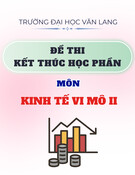
Chapter 31
Open-Economy Macroeconomics: Basic Concepts
TRUE/FALSE
1. A country with negative net exports has a trade surplus.
ANS: F DIF: 1 REF: 31-1
NAT: Analytic LOC: International trade and finance TOP: Net exports
MSC: Definitional
2. If a country’s imports exceed its exports it has a trade surplus.
ANS: F DIF: 1 REF: 31-1
NAT: Analytic LOC: International trade and finance TOP: Trade balance
MSC: Definitional
3. If a country sells more goods and services abroad than it purchases abroad, it has positive net exports and a
trade surplus.
ANS: T DIF: 1 REF: 31-1
NAT: Analytic LOC: International trade and finance TOP: Net exports
MSC: Definitional
4. Movies are a major export of the U.S.
ANS: T DIF: 1 REF: 31-1
NAT: Analytic LOC: International trade and finance TOP: U.S. trade statistics
MSC: Definitional
5. Perhaps the most dramatic change in the U.S. economy over the past four decades has been the increasing
relative importance of international trade and finance.
ANS: T DIF: 1 REF: 31-1
NAT: Analytic LOC: International trade and finance TOP: U.S. trade
MSC: Definitional
6. Reduced barriers to trade help explain an increase in U.S. exports and imports relative to GDP since 1950.
ANS: T DIF: 1 REF: 31-1
NAT: Analytic LOC: International trade and finance TOP: U.S. trade
MSC: Definitional
7. U.S. exports make up less than 20 percent of GDP.
ANS: T DIF: 2 REF: 31-3
NAT: Analytic LOC: International trade and finance TOP: U.S. trade
MSC: Definitional
8. Net capital outflow is the purchase of domestic assets by foreign residents minus the purchase of foreign assets
by domestic residents.
ANS: F DIF: 1 REF: 31-1
NAT: Analytic LOC: International trade and finance TOP: Net capital outflow
MSC: Definitional
9. When net capital outflow is negative, it means that on net the value of domestic assets purchased by foreigners
exceeds the value of foreign assets purchased by domestic residents.
ANS: T DIF: 2 REF: 31-1
NAT: Analytic LOC: International trade and finance TOP: Net capital outflow
MSC: Definitional
20

21 Chapter 31 /Open-Economy Macroeconomics: Basic Concepts
10. A rational investor will always purchase the bond that pays the highest real interest rate.
ANS: F DIF: 1 REF: 31-1
NAT: Analytic LOC: International trade and finance TOP: Foreign portfolio investment
MSC: Applicative
11. When a company from Germany builds an automobile factory in the United States, the German firm has
engaged in foreign direct investment.
ANS: T DIF: 1 REF: 31-1
NAT: Analytic LOC: International trade and finance TOP: Foreign direct investment
MSC: Definitional
12. Both foreign direct investment and foreign portfolio investment by U.S. residents increase U.S. net capital
outflow.
ANS: T DIF: 2 REF: 31-1
NAT: Analytic LOC: International trade and finance
TOP: Net capital outflow, Foreign direct investment, Foreign portfolio investment
MSC: Definitional
13. By itself, the purchase of a U.S. bond by a foreign resident decreases U.S. net capital outflow and increases
foreign capital outflow.
ANS: T DIF: 1 REF: 31-1
NAT: Analytic LOC: International trade and finance TOP: Net capital outflow
MSC: Definitional
14. For an economy as a whole, net exports must equal minus one times net capital outflow.
ANS: F DIF: 1 REF: 31-1
NAT: Analytic LOC: International trade and finance
TOP: Net capital outflow | Net exports MSC: Definitional
15. If a country’s net exports fall, then its net capital outflow rises.
ANS: F DIF: 1 REF: 31-1
NAT: Analytic LOC: International trade and finance
TOP: Net capital outflow | Net exports MSC: Definitional
16. If a U.S. firm buys Chinese toys using previously obtained Chinese currency, then both U.S. net exports and
U.S. net capital outflow decrease.
ANS: T DIF: 2 REF: 31-1
NAT: Analytic LOC: International trade and finance
TOP: Net capital outflow | Net exports MSC: Applicative
17. If a nation is selling more goods and services to foreigners than it is buying from them, then on net it must be
selling assets abroad.
ANS: F DIF: 2 REF: 31-1
NAT: Analytic LOC: International trade and finance
TOP: Net exports, Net capital outflow MSC: Interpretative
18. If a nation is selling more goods and services to foreigners than it is buying from them, then on net it must be
buying assets abroad.
ANS: T DIF: 2 REF: 31-1
NAT: Analytic LOC: International trade and finance
TOP: Net exports, Net capital outflow MSC: Interpretative

Chapter 31 /Open-Economy Macroeconomics: Basic Concepts 22
19. In every economy, national saving equals domestic investment plus net capital outflow.
ANS: T DIF: 1 REF: 31-1
NAT: Analytic LOC: International trade and finance
TOP: Net capital outflow | Net exports
20. When U.S. national saving rises, domestic investment also necessarily rises.
ANS: F DIF: 1 REF: 31-1
NAT: Analytic LOC: International trade and finance TOP: National accounts
MSC: Definitional
21. A nation with a trade surplus will necessarily have domestic investment that is greater than domestic saving.
ANS: F DIF: 2 REF: 31-1
NAT: Analytic LOC: International trade and finance TOP: Net exports, Saving
MSC: Analytical
22. The large trade deficits in the United States in the 1990s were primarily associated with a rise in domestic
investment rather than a rise in the budget deficit.
ANS: T DIF: 1 REF: 31-1
NAT: Analytic LOC: International trade and finance TOP: U.S. trade
MSC: Definitional
23. In an open economy, national savings can be less than investment.
ANS: T DIF: 1 REF: 31-1
NAT: Analytic LOC: International trade and finance TOP: National accounts
MSC: Definitional
24. If the exchange rate is 10 pesos per U.S. dollar, it is also 1/10 U.S. dollars per peso.
ANS: T DIF: 1 REF: 31-2
NAT: Analytic LOC: International trade and finance TOP: Nominal exchange rate
MSC: Analytical
25. If the exchange rate is 125 yen per dollar, then a hotel room in Tokyo that costs 25,000 yen costs $200.
ANS: T DIF: 1 REF: 31-2
NAT: Analytic LOC: International trade and finance TOP: Nominal exchange rate
MSC: Analytical
26. Other things the same, an increase in the nominal exchange rate raises the real exchange rate.
ANS: T DIF: 2 REF: 31-2
NAT: Analytic LOC: International trade and finance TOP: Real exchange rate
MSC: Applicative
27. If the real exchange rate of the U.S. dollar falls, U.S. net exports will fall.
ANS: F DIF: 1 REF: 31-2
NAT: Analytic LOC: International trade and finance TOP: Appreciation
MSC: Applicative
28. The theory of purchasing-power parity states that a unit of a country’s currency should be able to buy the same
quantity of goods in foreign countries as it does domestically.
ANS: T DIF: 1 REF: 31-3
NAT: Analytic LOC: International trade and finance TOP: Purchasing-power parity
MSC: Definitional
29. Purchasing-power parity says that the nominal exchange rate must equal the real exchange rate.
ANS: F DIF: 1 REF: 31-3
NAT: Analytic LOC: International trade and finance TOP: Purchasing-power parity
MSC: Definitional

23 Chapter 31 /Open-Economy Macroeconomics: Basic Concepts
30. Jason plans to buy shrimp in Florida and sell them in Ames, Iowa where the price is higher. Jason plans to
engage in arbitrage.
ANS: T DIF: 1 REF: 31-3
NAT: Analytic LOC: International trade and finance TOP: Arbitrage
MSC: Definitional
31. Many economists believe that the theory of purchasing-power parity describes the forces that determine
exchange rates in the long run.
ANS: T DIF: 1 REF: 31-3
NAT: Analytic LOC: International trade and finance TOP: Purchasing-power parity
MSC: Definitional
32. According to purchasing-power parity theory, the nominal exchange rate between the U.S. and another
country should equal the price level for that country divided by the price level for the U.S..
ANS: T DIF: 1 REF: 31-3
NAT: Analytic LOC: International trade and finance TOP: Purchasing-power parity
MSC: Definitional
33. If the purchasing power of the dollar is always the same at home and abroad, then the nominal exchange rate
defined as units of foreign currency per dollar decreases if the U.S. price level rises more than the price level
in foreign countries.
ANS: T DIF: 2 REF: 31-3
NAT: Analytic LOC: International trade and finance
TOP: Purchasing-power parity | Real exchange rate MSC: Analytical
34. Other things the same, an increase in the foreign price level leads to an increase in the real exchange rate.
ANS: F DIF: 2 REF: 31-2
NAT: Analytic LOC: International trade and finance TOP: Real exchange rate
MSC: Analytic
35. If prices in the U.S. rise faster than prices in the United Kingdom, then according to the doctrine of
purchasing-power parity the U.S. nominal exchange rate should fall.
ANS: T DIF: 2 REF: 31-3
NAT: Analytic LOC: International trade and finance TOP: Purchasing-power parity
MSC: Interpretative
36. According to the theory of purchasing-power parity, the real exchange rate defined as foreign goods per unit
of U.S. goods will equal the exchange rate defined as units of foreign currency per dollar times the domestic
price level divided by the foreign price level.
ANS: T DIF: 1 REF: 31-3
NAT: Analytic LOC: International trade and finance TOP: Purchasing-power parity
MSC: Definitional
37. In the 1970s and 1980s the U.S. dollar depreciated against the German mark and appreciated against the
Italian lira because U.S. inflation was lower than in Germany but higher than in Italy.
ANS: F DIF: 1 REF: 31-3
NAT: Analytic LOC: International trade and finance
TOP: Purchasing-power parity | U.S. exchange rates MSC: Definitional
38. When the central bank of some country prints large quantities of money, that county’s currency loses value
both in terms of the goods and services it buys and in terms of the amount of foreign currencies it can buy.
ANS: T DIF: 2 REF: 31-3
NAT: Analytic LOC: International trade and finance TOP: Purchasing-power parity
MSC: Analytical

Chapter 31 /Open-Economy Macroeconomics: Basic Concepts 24
SHORT ANSWER
1. List the factors that might influence a country's exports, imports, and trade balance.
ANS:
a. the tastes of consumers for domestic and foreign goods
b. the prices of goods at home and abroad
c. the exchange rates at which people can use domestic currency to buy foreign currencies
d. the costs of importing goods from country to country
e. the policies of the government toward international trade
DIF: 2 REF: 31-1 TOP: Trade balance
MSC: Applicative
2. Suppose that Bill, a resident of the U.S., buys software from a company in Japan. Explain why and in what
directions this changes U.S. net exports and U.S. net capital outflow.
ANS:
The purchase of a foreign good by a U.S. resident is a U.S. import. Since net exports = exports - imports, net exports
decrease. Bill pays for the software with U.S. dollars so that the Japanese have obtained more U.S. assets. Since, net
capital outflow = the amount of foreign assets acquired by domestic residents - domestic assets acquired by foreign
residents, the increase in foreign holdings of dollars by Japanese residents decreases U.S. net capital outflow.
DIF: 3 REF: 31-1
TOP: Net capital outflow | Net exports MSC: Analytical
3. Why are net exports and net capital outflow always equal?
ANS:
Net exports and net capital outflow are always equal because every international transaction is an exchange. When a
seller country transfers a good or service to a buyer country, the buyer country gives up some asset to pay for this
good or service. The value of that asset equals the value of goods and services sold. Hence, the net value of goods
and services sold by a country (NX) must equal the net value of assets acquired (NCO).
DIF: 3 REF: 31-1
TOP: Net capital outflow | Net exports MSC: Analytical
4. Colonial America had little industry and so had mostly raw materials to export. At the same time, there were
many opportunities to purchase capital goods and earn a high rate of return because there was little existing
capital so that the marginal product of capital was relatively high. What does this suggest about net exports
and net capital outflow in colonial America?
ANS:
Net exports were negative because the value of exports was low, and the colonies imported capital goods. If net
exports were negative, net capital outflow must also have been negative. Net capital outflow would have been
negative because the colonies sold stocks, bonds, and other domestic assets to buy capital goods from abroad.
DIF: 2 REF: 31-1
TOP: Net capital outflow | Net exports MSC: Applicative

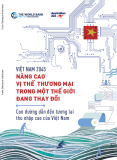
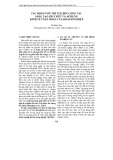

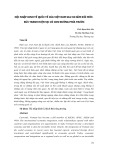





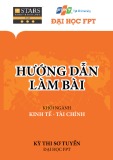


![Bài tập Kinh tế vi mô kèm đáp án [chuẩn nhất]](https://cdn.tailieu.vn/images/document/thumbnail/2025/20250923/thaovu2k5/135x160/19561758679224.jpg)


